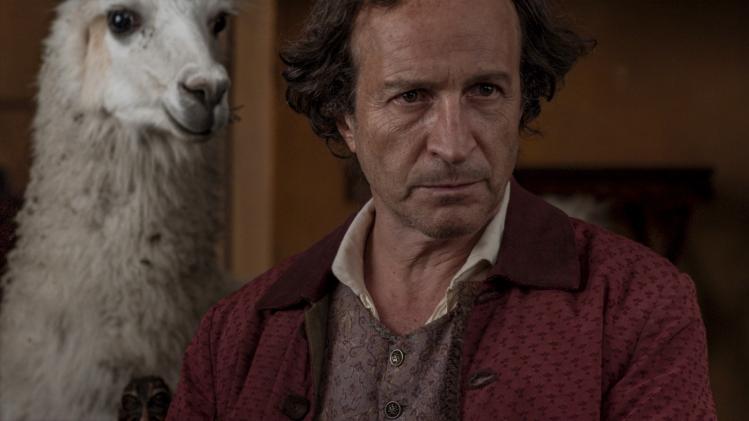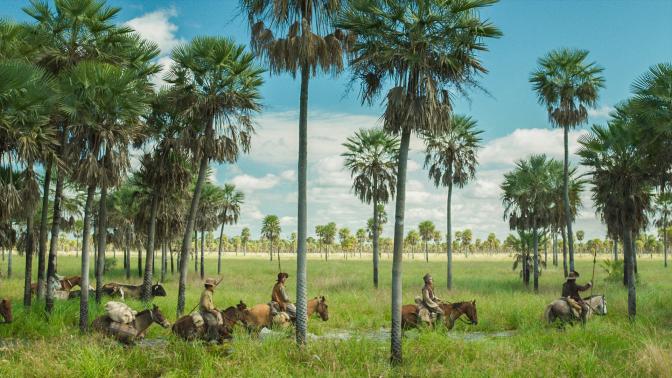
Of the many indignities suffered by the beleaguered colonial official at the center of Lucrecia Martel’s new film, Zama, none is as humiliating as when he’s upstaged by a dirty, rambunctious llama. Don Diego de Zama, “the forceful executive, the pacifier of Indians, the warrior who rendered justice without recourse to the sword,” is second-in-command in a far-flung region of rural Paraguay during the twilight years of the Spanish Empire in the 1790s. Separated from his family and languishing in malaise, he awaits transfer to a post in keeping with his rank. But when summoned to the office of the gobernador he learns that the prize will go to his subordinate. Martel shoots his pained reaction in close-up, but her camera seems more interested in the antics of the stray llama prancing back and forth behind him. It’s an absurd, hilarious scene, also emblematic of the film as a whole: Zama not only punctures the pretensions of its hapless hero, but also ruthlessly dismantles the entire colonial world he represents.
Zama, Martel’s fourth film and first in nine years, is also her first literary adaptation, based on the classic 1956 novel by Argentine writer Antonio Di Benedetto. Martel herself is one of the most talented directors to emerge from the New Argentine Cinema movement, which erupted in the mid-1990s as an iconoclastic response to Argentina’s post-dictatorship conformism. She’s best known for her Salta Trilogy, three loosely connected films that employ documentary-like realism, regional dialogue, and elliptical editing to expose the vacuity of the country’s elite. With Zama, Martel deepens and expands her project, using the past as a moral lens to frame the social paradoxes of the present. She first read the book by chance on a camping trip along the Paraguay River, where a “crazed euphoria” seized her and convinced her to make the film. Like Federico Fellini’s extravagant adaptations of literary classics, such as Petronius’s Satyricon or Casanova’s History of My Life, Martel’s Zama is highly personal and idiosyncratic, reflecting all the energy and excitement of that first, fevered reading.

The critical response to the film has been overwhelmingly positive, and for good reason. Filmed on location in rural Argentina, Zama unfolds amidst wide rivers, long beaches, steep cliffs, and lush swamps full of palms and swaying grasses. Like a master painter, Martel carefully stages her characters (dressed in lavish period costumes of pink, red, and gold) in poses suggestive of formal European portraits of the eighteenth and nineteenth centuries (Goya immediately comes to mind). But she tempers the beauty with tense scenes set in dark interiors, like the stuffy salons of the nobility, the crypt of a church, and Don Diego’s own crumbling quarters. Throughout the film, the European colonizers appear out of place and ill at ease, spending their days adjusting their wigs, complaining about the heat, and drinking endless glasses of mate and aguardiente, a local liqueur. Martel centers many of her shots on those who bear the weight of colonialism’s evils, especially the African slaves and indigenous Guaranís who are forced to serve — whether fanning their masters or transporting them by chairs strapped to their backs. Thus she exposes the narcissism at the heart of colonialism, as the blind refusal to acknowledge reality (especially the concrete misery of the victims) paves the way for centuries of socioeconomic injustice.
But Zama is even more so a psychological drama, a record of Don Diego’s descent into madness. In adapting Di Benedetto's first-person prose, Martel faces a considerable challenge: How to make viewers care about and even identify with such an utterly unsympathetic antihero? The novel encourages an ironic distance from Don Diego, as readers quickly learn to see his blind spots and question his self-serving monologues. Martel permits viewers no such separation, instead inducing us to share the same disorientation by removing all references to time and place, editing scenes elliptically and without establishing shots, and utilizing off-screen sounds (like creaking fans, ringing bells, and animal noises) to distract our attention from the events on-screen.
Martel cleverly dramatizes her adaptive strategy, which cleanses the novel of its clinical detachment from the erratic mind of Don Diego, in one long, haunting close-up. Lasting more than a minute, the shot shows three women surrounding Don Diego’s tired body, scrubbing him with soapy water as he converses with his absent wife. Over the hypnotic course of this scene, we relax along with Don Diego as we shed the tension of the rest of the film. This uncanny moment reveals Martel’s singular view of cinema’s visceral power, in which the interior landscapes of her characters’ psyches take precedence over narrative arc. “The plot,” as she reminded the audience at a screening in New York City, “is not important. It’s like the foam churned up on the surface of the ocean.”
But why would Martel turn to Di Benedetto for such an avant-garde project? The answer lies in her attraction to the existential crisis at the center of the novel. Dedicated to the “victims of expectation,” it recounts Don Diego’s spiritual breakdown in systematic, Dostoevskian fashion. Like Raskolnikov from Crime and Punishment or Ivan from The Brothers Karamazov, Don Diego suffers helplessly as larger systems of meaning fail. But where Dostoevsky’s characters operate against the backdrop of divine grace, Zama offers its protagonist no theological possibility of redemption: God, as Don Diego imagines him, is lonely, angry, and malevolent, nothing more than “an old man with white hair and beard, sitting on a rock in fatigued contemplation of a mute universe.”
If the breakdown of religious certainty ensnares Di Benedetto’s Don Diego in a cycle of frenetic despair, for Martel this same disruption creates new opportunities and freedoms. Now an admitted atheist, Martel grew up a fervent Catholic. In an interview she reveals that as she entered adulthood, her earlier piety gave way to a sudden, intense skepticism. She explains that this “divine abandonment” was hardly “sad or paralyzing” but instead “immense and marvelous.” Paradoxically, her loss of faith enabled a deeper appreciation of the wonder and mystery of the world. In another interview, Martel applies the same logic to Don Diego, equating his spiritual breakdown with a religious journey into the wilderness:
“When you go to the desert—and that’s why the anchorites and the mystics went to the desert—you face that terrible encounter with the universe, especially at night, where darkness allows us to see better. And we are outdoors, without all the inventions with which we have concealed the enormous absurdity of existence, and for that very reason, it’s something wonderful. In my films I try to create the outdoors.”
In this sense, Martel’s Zama traces a theological via negativa (which arrives at the knowledge of God by stating what God is not). It takes us “outdoors,” that is, away from our conventional idols and familiar patterns of thinking. Any breakdown, Martel hints, only seems like the end; in reality, it’s the mysterious start of something new.
Though hardly a mystic and far from a saint, in the film’s final segment Don Diego makes a journey into the wilderness that leaves him physically mutilated but spiritually liberated. Hoping to finally secure his transfer, he enlists with a group of soldiers charged with tracking down and killing Vicuña Porto, a local bandit. The quest instantly devolves into a spectacular failure. Now wizened and frail, Don Diego is captured and tortured by indigenous warriors, and then betrayed by a member of his own group (who turns out to be Vicuña himself). As if mirroring Don Diego’s consciousness, Martel shoots the entire sequence (at over thirty minutes, it feels like a separate film) with dreamlike pacing, now fast and energetic, now slow and bewildering.
The ordeal culminates in the brutal amputation of Don Diego’s forearms, but Martel never strips her protagonist of his personhood. Bloodied, dehydrated, and bound by the neck, he comes to terms with the reality that his hopes for a transfer, like the riches sought by his captors, have always been illusory. He meets it not with despair or even stoic indifference but rather with an almost holy reverence for his shattered life: choosing not to bleed to death, he eventually is rescued by two Guaranís paddling a canoe. Martel again shoots him in close-up, barely alive but beginning to smile as light, festive music plays (the soundtrack features Los Indios Tabajaras, a mid-twentieth-century Brazilian guitar duo). It’s a reversal of the llama scene: Don Diego’s dignity is restored as he affirms, with a scarcely audible gasp, that yes, he wants to live.
Martel likes to call Zama a film with a happy ending. And there is a way in which the loss of certainty and security can be paradoxically productive, even generative of hope. In our time of political division and spiritual confusion, Martel’s cinema offers us a way of reframing what might otherwise seem like pure disaster. The way forward is hardly certain. But as the mystics dear to Martel demonstrate, even dark paths can lead us to freedom. As with Don Diego, it will probably cost us something, maybe even something very dear. Better, though, to enter life maimed than to be thrown into eternal fire.
Please email comments to [email protected] and join the conversation on our Facebook page.
Share
Previous Story
Civic Virtue & the Common Good
Next Story
From Eternity to Here